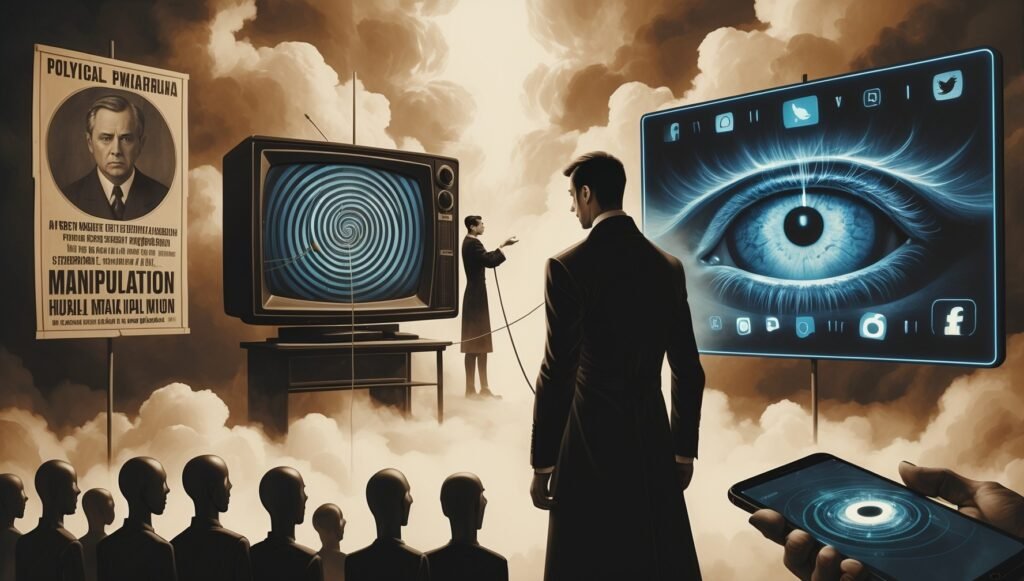|
Getting your Trinity Audio player ready...
|
The art and science of manipulation have evolved dramatically over the last century, shifting from rudimentary propaganda to sophisticated psychological warfare, subliminal messaging, and digital deception. Techniques once confined to government operations and corporate advertising have now permeated social media, entertainment, and even interpersonal relationships. This article delves into the most significant manipulation strategies from the early 20th century to today, uncovering the mechanisms that shape public perception and behavior.
What is Manipulation?
Manipulation is the strategic influence exerted over individuals or groups to shape their thoughts, emotions, or behaviors, often without their conscious awareness. This can be achieved through deceptive tactics, coercion, emotional appeals, or psychological conditioning. While persuasion is a natural part of human interaction, manipulation differs in its intent—often prioritizing the manipulator’s benefit at the expense of the manipulated.
How Manipulation Affects Your Decisions
Everyday decisions, from political choices to purchasing habits, can be influenced by manipulation. Media outlets, advertisers, and social platforms leverage psychological biases such as confirmation bias (seeking information that aligns with existing beliefs) and the bandwagon effect (following the majority) to shape consumer and societal behaviors. The subtle nature of these tactics makes them particularly effective, as people often believe they are acting out of free will when, in reality, their perceptions have been subtly steered.
Risks and Dangers of Manipulation
The dangers of manipulation extend beyond individual decision-making. Societal division, misinformation, financial exploitation, and political instability can all stem from mass manipulation tactics. In extreme cases, manipulation has been used to justify wars, suppress dissent, and fuel radical movements. The digital era has amplified these risks, as misinformation spreads rapidly, often outpacing fact-checking efforts. Individuals and institutions must remain vigilant to recognize and counteract manipulation strategies effectively.

20th Century Manipulation Techniques
The early 1900s witnessed the rise of mass communication, which governments and corporations quickly harnessed for propaganda. Edward Bernays, often called the “father of public relations,” revolutionized advertising and political messaging by applying psychological principles. His seminal book Propaganda (1928) detailed how public opinion could be shaped through controlled messaging, leveraging Freudian psychology to influence desires and behaviors.
During both World Wars, state-sponsored propaganda became a powerful tool. Governments used posters, radio broadcasts, and films to instill nationalism, demonize enemies, and control narratives. The Nazi regime, under Joseph Goebbels, perfected these strategies, using emotionally charged language and repetitive messaging to manipulate public sentiment.
Mid-20th Century: Psychological Warfare and Behavioral Conditioning
The Cold War ushered in new psychological warfare tactics. The CIA’s MKUltra program (1950s-1970s) experimented with mind control, using hypnosis, drugs, and psychological manipulation. Though officially disbanded, declassified documents suggest these studies laid the groundwork for more refined persuasion techniques.
Meanwhile, behaviorist psychologists like B.F. Skinner explored operant conditioning, influencing individuals through rewards and punishments. This research was soon integrated into advertising and political campaigns, fine-tuning messaging to evoke desired responses.
In the 1960s and 1970s, subliminal messaging gained popularity. Studies, such as James Vicary’s infamous “Eat Popcorn, Drink Coke” experiment, claimed that flashing imperceptible messages in films could alter consumer behavior—though later debunked, the idea fueled public concern over covert manipulation.
Late 20th Century: Media Manipulation and Mass Influence
By the 1980s and 1990s, television and mass media became the dominant tools for shaping perception. News outlets, advertising agencies, and political strategists refined emotional appeals, leveraging cognitive biases like the “availability heuristic” (favoring readily available information) and “confirmation bias” (seeking information that aligns with beliefs).
The 1990s also saw the rise of “infotainment,” where news blurred with entertainment. Sensationalism, fear-mongering, and selective reporting began dominating headlines, manipulating public reactions for higher ratings and political gains.
In 1994, journalist Noam Chomsky co-authored Manufacturing Consent, arguing that media conglomerates serve elite interests by controlling narratives and suppressing dissenting views.

21st Century: Digital Manipulation and Algorithmic Control
With the advent of the internet and social media, manipulation techniques have reached new heights. Algorithmic bias, deepfake technology, and psychological profiling allow for highly personalized persuasion.
Social Media Manipulation
Platforms like Facebook and Twitter became battlegrounds for psychological influence. The Cambridge Analytica scandal (2018) exposed how personal data was harvested and used to micro-target voters with emotionally charged political ads, influencing elections worldwide.
Deepfake Technology and Misinformation
Deepfake videos—AI-generated fabrications—have created a new era of deception, making it nearly impossible to distinguish truth from fiction. Studies, such as those conducted by MIT’s Media Lab, reveal how misinformation spreads faster than verified news, increasing public susceptibility to manipulation.
Psychological Operations (PsyOps)
Governments and corporations have refined psychological operations, using behavioral data to predict and influence human actions. Techniques like “nudging” (subtly steering decisions) and “astroturfing” (creating fake grassroots movements) shape opinions without individuals realizing it.
The Future: AI, Neuromarketing, and Ethical Concerns
Looking ahead, artificial intelligence (AI) and neuroscience-based marketing (neuromarketing) will further refine manipulation techniques. AI-driven chatbots and personalized content can shape perceptions in real-time, while neuroimaging studies explore how brain activity influences decision-making. This raises ethical concerns about free will and autonomy in an era of pervasive persuasion.
Stay Informed and Protect Yourself!
Understanding these techniques is the first step in resisting manipulation. Critical thinking, media literacy, and verifying sources can help individuals navigate a landscape where deception is increasingly sophisticated.
Stay tuned for more in-depth analysis on this topic—check back daily as we continue uncovering the hidden forces shaping our world.
What are your thoughts on these evolving manipulation strategies? Have you encountered digital deception in your daily life? Leave a comment and share your insights.









